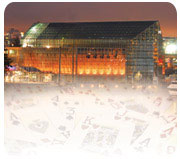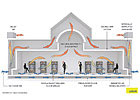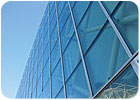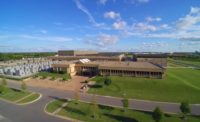
This design team faced a building with some unusual see-through characteristics, a city regulation, and the usual casino-related challenges. Read on for the thorough combination of engineering discussion and modeling that eventually made this Canadian casino the place for displacement.
In 2004, Broadway Refrigeration, a Vancouver D-B mechanical contractor, approached Cobalt Engineering with an interesting challenge: turn a “glass box” into a comfortable casino, quickly, and within a budget (naturally!). Our Cobalt team was initially brought in due to our background in thermal modeling. Broadway knew we could provide energy performance recommendations for the yet-to-be-chosen mechanical system. However, the project quickly became a prime example of inte-grated design; after we suggested an “out of the box” envelope solution, we were hired to define and design the optimal mechanical system in collaboration with the design team.
Apart from the obvious challenge of mitigating the high solar load of a glass box paired with internal gains from casino equipment and a crowded gambling floor, there were additional requirements from the client and the city of Vancouver. The building was originally built on the banks of False Creek for Expo ‘86 and because of that historical significance, the city required that the existing steel-framed glass envelope not be altered in any way. (In recent years, it was only used for nighttime functions, when there was no solar load to consider.)
In addition, its transparency had to be maintained; the envelope had to allow passers-by to see “life within the building.” Unfortunately, this conflicted with the client’s requirement that solar glare not affect the security cameras stationed around the casino. Furthermore, the casino owners preferred that occupants not be distracted by outside activities, again working against the city’s transparency requirement. Finally, the project was to serve only a temporary purpose, as a more permanent casino was to be developed at a different location. As a result, the budget was not as high as one might expect for a casino, and the timeline was very tight since the owners wanted an operating facility as quickly as possible.

FIGURE 1. A schematic of the double façade and displacement ventilation system used in the casino.
The Options
Our first thermal and energy model of the existing building conditions quickly confirmed that before we could consider any mechanical system options, we had to address the issue of the all-glass envelope. It had an enormous effect on the heating and cooling loads, especially in the summer when the solar gain would heat the space to uncomfortable conditions as soon as the sun hit it, in addition to the glass itself absorbing radiation, warming up and further radiating heat into the space. Conversely, but equally important, winter heat losses through the glass were also difficult to alleviate.Although briefly considered, the options of attaching external shading devices, adding an external double façade, applying a low-e coating to the existing glazing, or replacing it altogether with high-performance glazing were all out of the question due to the city’s requirements, capital costs, and delivery time. Another option that seemed more viable was to lower the temperature of the existing glazing via evaporative cooling, thereby alleviating the effect of the hot glass radiating heat into the space. We generated a model where water was sprayed on the outside of the glazing to cool it and the logistics were considered, but the method proved impractical and a waste of water.
The most effective solution - and the one that best reduced the building loads - turned out to be the addition of a second façade, but there was a catch. Contrary to standard designs, the second façade would have to be added on the inside of the structure and would be an opaque wall made of a fabric similar to movie screens. The life within the building requirement from the city would be met with a low-energy, LED lighting scheme between the skins that would create the illusion of activity inside.
Once we chose the envelope upgrade and determined the peak heating and cooling loads, our next challenge was to select an appropriate mechanical system. The inner building skin had removed the effects of the glass box envelope and the casino floor was now a cooling-dominant load. The existing building had several AHUs and high-level, four-pipe fancoil units, but these weren’t very practical for the intense cooling loads required by a casino or for such a high space.
A more traditional approach for casinos is UFAD, as many casinos already use raised floors to conceal wiring to and from gambling equipment and lights. However, traditional UFAD was ruled out because of its reputation for creating uncomfortable areas of cold, fast-moving air drafts where occupants could be seated for long periods of time.
A less-traditional system considered was the use of radiant panels to heat and cool the space, with a mixed-mode air system (natural and displacement ventila-tion) taking in outdoor air at low level and exhausting through the high atrium space. The radiant panels would be mounted on the underside of false ceilings in the main areas and in dropped ceilings over the card tables. Hot or cold water would circulate through small tubes embedded in the ceilings beneath a light drywall topping; the heat (or coolness when in cooling mode) would then radiate down to the occupants.
Unfortunately, an adequate combination of surface area and cooling water temperature could not be reached; there either wasn’t enough ceiling surface area (espe-cially in the main gambling area under the atrium, which was perpetually in cooling mode), or the water could not be adequately cooled without passing the dewpoint and introducing condensation problems. Natural ventilation would have been a good method of ventilation with the tall, central atrium using natural stack effect to allow the hot air to rise upwards and out of the building, but without alternate (non-air) means of heating and cooling the space, it would have been ineffective.
The Solution
The most efficient solution turned out to be a displacement cooling system. This system would take advantage of the standard raised casino floor and the stack effect created by the atrium. The displacement cooling also reduced our cooling load in the occupied space (the lower 8 ft above the floor), as convective heat from overhead lighting and equip-ment never reaches the occupied space. This lowered the amount of supply air required and allowed us to use higher temperatures for the supply air. The non-mixing low ve-locity delivery also eliminated the drafts that can occur with conventional UFAD systems.At the same time, we could address the constant cooling load of the central space separately from the varying perimeter loads in the double façade void area. We installed dedicated fancoil units in the double façade to handle the heating and cooling loads from the outside skin in the space between the inside layer of fabric and the outside layer of glazing. A picture truly is worth a thousand words, and Figure 1 shows how the double façade and the displacement cooling system function together to condition the casino.

FIGURE 2. A close-up of the new double façade from the outside. (Photo courtesy of Edgewater Casino.)
Double Façade
The final design incorporates an interior opaque wall of fabric to create the double façade. We met the city’s life within the building requirement by including a lighting system in the void between the skins that mimics the look of normal building operations. The inside skin addressed the issue of sun glare on the security cameras as no natural light penetrated into the casino gaming space.A double façade is a passive way of reducing or eliminating the effects of the skin loads due to seasonal temperature variations. The design is particularly effective be-cause it doesn’t fight the laws of physics. Low-level intake louvers and high-level exhaust louvers throughout the façade handle the air between the two skins. In addition, dedicated air fancoil units were installed at ground level within the double façade to assist with air movement in the void space when necessary.
In the summertime, when solar gains are high, these units assist the natural air movement patterns, from cooler low levels to warmer high levels. As the cooler air moves through the skin, it both removes heat trapped within the façade and cools the internal wall before being exhausted at the top of the structure. It thereby elimi-nates much of the solar gain from penetrating into the occupied space and the effect of the glass absorbing solar energy, warming up, and radiating into the space. Similarly, in the winter, the fans blow hot air up through the double façade to warm the glazing. This removes the negative radiative effect of the cold glass and miti-gates the heat loss.
Whenever possible, the air handlers are turned off and all vents opened to allow for natural ventilation, using the effects of temperature stratification and air pressure differences to naturally draw in intake air and relieve hot exhaust air. The units can use outdoor air, return air, or a combination of both - whichever is more effective for the current heating/cooling load. Using outdoor air can be especially effective due to the casino’s location on the bank of Vancouver’s False Creek; the nearby water naturally cools the surrounding low-level air.
Displacement Cooling
With the varying skin heating and cooling loads effectively handled by the double façade, the remaining challenges for the mechanical system were to provide adequate ventilation and mitigate the internal gains of the casino. As casinos are open long hours, brightly lit, filled with slot machines and other energy-intensive equipment, and often crowded with people, these loads were significant. The displacement cooling system addressed all of these concerns.We made an important distinction during the design process between displacement cooling and the more traditional UFAD system. UFAD designs use floor-mounted grilles to swirl cold air into the space at higher velocities, attempting to mix the space air and the supply air to prevent drafts. The displacement system, on the other hand, features specially designed sidewall and floor-mounted basket diffusers (1,300 of them) that “dribble” air out at lower velocities (no more than 50 fpm).
The air is also supplied at higher temperatures than a UFAD system - approximately 2°F to 3° below the internal design temperature. This cooler air “puddles” at the floor level of the space because of the temperature differential. Physical objects such as tables and shelves (anything other than a solid wall) are not problematic, as the air just pools around them. When the cool air reaches a heating source such as a person, or slot machine, it warms up and rises past them, to be exhausted at the top of the space, in this case, by the existing AHUs or by natural means when possible. EH Price, the supplier, actually built a mock-up of a small area of the casino at its plant in Winnipeg to demonstrate the system’s effectiveness. All of the desired effects were tested and confirmed by both the EH Price mock-up and our energy modeling.
This system provides several advantages over the UFAD or traditional overhead supply systems. The warmer supply air temperature allows for more free cooling throughout the year. When coupled with the low supply velocity, it also eliminates uncomfortable cold spots and drafts. The low velocity also creates very quiet space (not that noise is an issue in a casino gaming area). In addition, the system can provide either 100% outdoor air for better air quality or return air for energy efficiency. The system uses CO2 sensors to constantly evaluate the two options, and its automatic controls maintain good IAQ. The low velocity delivery and reduced duct losses also in-crease the system’s energy efficiency of the system.
The displacement cooling design is a good match for the double façade, because it also works with the laws of physics rather than against them. It takes advantage of natu-ral stratification to exhaust warm, “used” air and only conditions the lower, occupied space. This works especially well in this double-height building. The question of dehumidification arose, which is not generally a consideration in Vancouver’s mild climate. Dehumidification was built into the system by providing the heating coil down-stream of the cooling coil for all of the interior fancoil units, but it hasn’t been needed yet. We achieved this at no extra cost; the simple rearrangement of the coils allows us to first dehumidify with the cooling coil if we need to, and then reheat the air if warm air is required.
One challenge did arise within the first year of operation: during the winter, the high heat losses at the entryway due to constantly opening doors were difficult to han-dle by blowing warm air in the façade and with the displacement system delivering air just below room temperature. To solve this problem, the entryway was redes-igned with a welcoming vestibule, with offset interior and exterior doors to keep the warm interior air from rushing out and the cold exterior air from rushing in. This entryway challenge requires careful consideration in any climate, hot or cold.
Conclusions
Since completion and amendment of the entry vestibule in 2005, the double façade and displacement cooling system have been a huge success. Although a temporary project, the building has become a key example of displacement cooling, especially for the niche casino market. At the time of completion, this building was the largest application of displacement cooling in North America. Casino owners from Las Vegas have toured the facility to examine the displacement ventilation system and ex-plore the possibilities it offers for smoking environments. Smoke would simply rise up with the stratified air and get exhausted to the outside without ever mixing with the low-level supply air. This would be a practical, low-cost, energy-efficient alternative to the traditional “muscle” approach of high exhaust volume, which is energy-intensive and creates uncomfortable drafts.The project was a learning experience for all involved, and a great opportunity to apply integrated design and modern engineering solutions tied to the oldest laws of physics.ES
For more information, visitwww.cobaltengineering.com.





